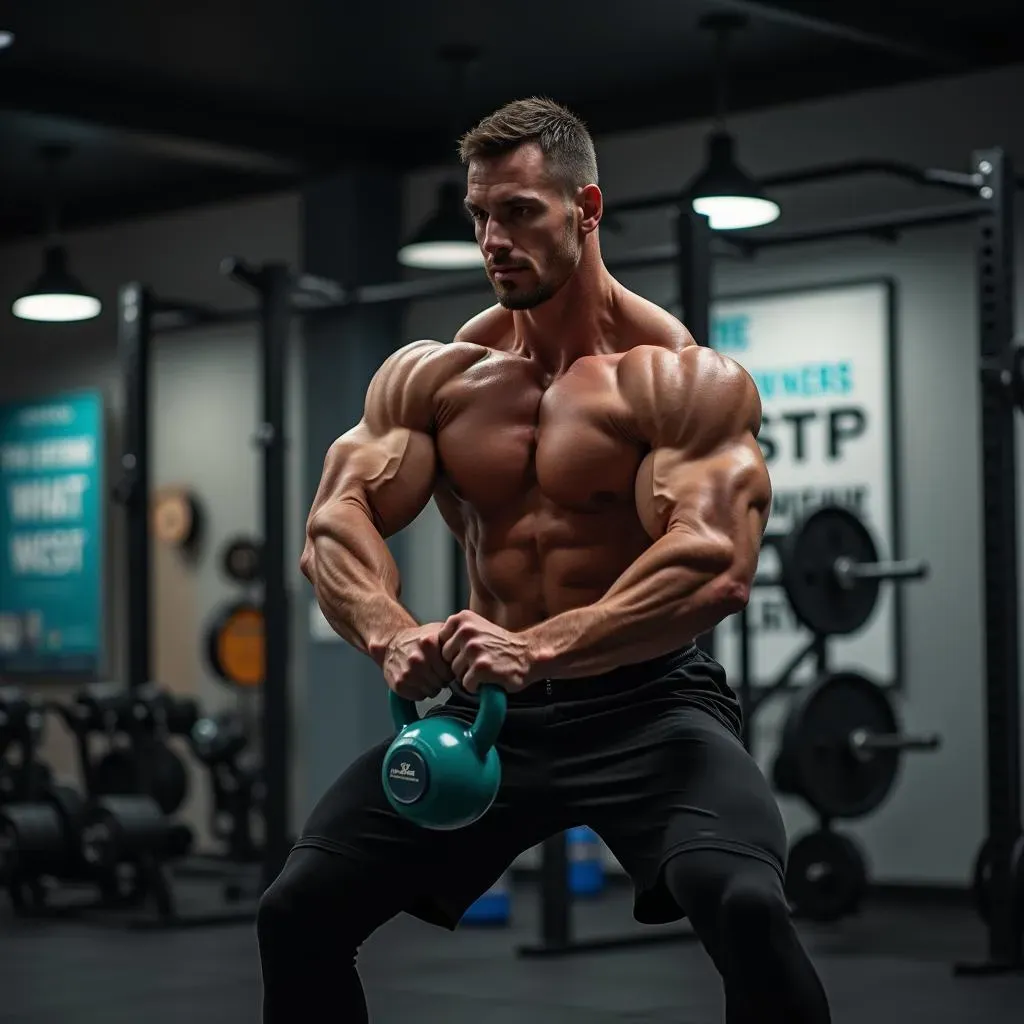Table of Contents
Ready to ditch the dumbbells and forge a powerful, sculpted physique with just one tool? Then you're in the right place. This isn't your grandma's kettlebell class; we're talking serious strength and definition. A full body kettlebell workout for bodybuilding is a dynamic and effective way to build muscle, burn fat, and boost your overall fitness. Forget endless hours on machines – kettlebells offer a unique blend of strength, power, and cardio, all rolled into one compact package. This guide will walk you through everything you need to know to start your own kettlebell bodybuilding journey. We'll cover the key benefits of kettlebell training, dive into essential exercises that target every major muscle group, and show you how to craft a workout routine that's tailored to your goals. You'll also learn the proper form and technique for each exercise, ensuring you get the most out of every rep while minimizing the risk of injury. Finally, we'll explore advanced techniques and progressions to keep your workouts challenging and your progress steady. So, grab your kettlebell, and let's get to work!
Why a Full Body Kettlebell Workout is a Bodybuilding Game Changer

Why a Full Body Kettlebell Workout is a Bodybuilding Game Changer
Unlocking Full-Body Potential with Kettlebells
So, you're thinking about adding kettlebells to your bodybuilding routine? Awesome choice! Let's be real, bodybuilding can sometimes feel like a collection of isolated movements. You hit chest on Monday, back on Tuesday, and so on. But what if you could work multiple muscle groups simultaneously, boosting your strength and burning calories at the same time? That's where the kettlebell comes in. It's not just about swinging a weight around; it's about integrating your entire body into each movement. Think of it as functional fitness meets hypertrophy – a match made in bodybuilding heaven.
Kettlebells force you to engage your core, stabilize your spine, and coordinate your movements in a way that dumbbells and barbells often don't. This translates to real-world strength and improved athletic performance. Plus, the dynamic nature of kettlebell exercises elevates your heart rate, giving you a cardio boost without having to step on a treadmill. Who doesn't love saving time?
More Than Just Cardio: Building Muscle with Kettlebells
Don't let anyone tell you kettlebells are just for cardio. When used correctly, they can be incredibly effective for building muscle. The key is to focus on compound movements that challenge multiple muscle groups at once. Exercises like swings, cleans, snatches, and Turkish get-ups engage your legs, glutes, core, back, and shoulders, leading to significant muscle growth and strength gains. And because kettlebells often involve unilateral movements (working one side of the body at a time), they can help correct muscle imbalances and improve stability.
Think about the swing, for instance. It's not just an arm exercise; it's a powerful hip hinge movement that targets your glutes and hamstrings while simultaneously engaging your core and back. Or consider the Turkish get-up, a full-body exercise that requires strength, mobility, and coordination. These are the kinds of movements that build a well-rounded, functional physique – the kind that looks good and performs even better.
Essential Kettlebell Exercises for a Killer Full Body Workout

Essential Kettlebell Exercises for a Killer Full Body Workout
The Foundational Movements: Kettlebell Swings and Goblet Squats
Alright, so you're ready to dive into the best kettlebell exercises? Let's start with the basics. First up, we've got the kettlebell swing. This isn't just about flailing your arms; it's a powerful hip hinge movement that ignites your posterior chain – glutes, hamstrings, and back. Think of it like a deadlift, but with more explosiveness. Master the swing, and you'll unlock a ton of power and athleticism. It's the cornerstone of any solid kettlebell routine.
Next, we've got the goblet squat. Hold the kettlebell close to your chest, like you're cradling a baby (a heavy, iron baby), and squat down as low as you can while maintaining good form. This exercise is fantastic for building leg strength and improving your squat mechanics. The kettlebell acts as a counterbalance, helping you maintain an upright posture and go deeper into the squat. It's a great way to warm up before heavier lifts or as a standalone exercise for building lower body strength and stability.
- Kettlebell Swing: Master the hip hinge, engage your glutes and hamstrings.
- Goblet Squat: Improve squat depth and posture, build leg strength.
The Power Builders: Cleans, Snatches, and Turkish Get-Ups
Now that you've got the basics down, let's move on to some more advanced movements that will really test your strength and coordination. The clean is a dynamic exercise that involves lifting the kettlebell from the ground to a racked position (resting on your forearm) in one smooth motion. It's a great way to build explosive power and improve your overall athleticism. From the clean, you can progress to the snatch, which takes the kettlebell all the way overhead. The snatch requires even more power and coordination than the clean, but it's an incredibly rewarding exercise that will challenge your entire body.
Finally, we have the Turkish get-up, a full-body exercise that requires strength, mobility, and coordination. It involves transitioning from a lying position to a standing position while holding a kettlebell overhead. The Turkish get-up is a complex movement that requires patience and practice, but it's an incredibly effective exercise for building strength, stability, and overall body control. It's like a moving plank that hits every muscle in your body. Seriously, try it – you'll feel muscles you didn't even know you had.
Exercise | Benefits | Tips |
|---|---|---|
Clean | Explosive power, athleticism | Focus on technique, use your hips. |
Snatch | Full-body strength, coordination | Start light, practice the movement. |
Turkish Get-Up | Strength, mobility, body control | Break down the steps, be patient. |
Crafting Your Full Body Kettlebell Workout Routine for Bodybuilding Gains

Crafting Your Full Body Kettlebell Workout Routine for Bodybuilding Gains
Setting Up Your Week: Frequency and Split
Alright, let's talk routine. When it comes to full body kettlebell workout for bodybuilding gains, consistency is key. Aim for 2-3 full body kettlebell workouts per week, with rest days in between. This allows your muscles to recover and rebuild, which is crucial for hypertrophy. You don't want to overdo it and risk injury or burnout. Listen to your body and adjust the frequency as needed. Now, about the split, you could do a simple full body routine each workout or alternate between two different routines to hit your muscles from slightly different angles. Variety is the spice of life, and it can also help prevent plateaus.
For example, Monday could be workout A, Wednesday could be rest, Friday workout B, and then the weekend for more rest or active recovery like light cardio or stretching. Play around with it and find what works best for your schedule and recovery abilities. Remember, this is a marathon, not a sprint. Sustainable progress is the name of the game.
Choosing the Right Exercises: Compound Movements are King
When you're crafting your full body kettlebell workout routine for bodybuilding gains, focus on compound movements that work multiple muscle groups at once. These exercises are the most efficient for building muscle and burning calories. Think swings, cleans, snatches, goblet squats, and Turkish get-ups. These movements not only build strength and muscle, but also improve your coordination, balance, and overall athleticism.
Don't be afraid to experiment with different variations of these exercises to target specific muscle groups. For example, you could do single-leg deadlifts to target your glutes and hamstrings or overhead presses to work your shoulders and triceps. The key is to choose exercises that challenge you and that you enjoy doing. If you hate your workouts, you're less likely to stick with them.
- Swings: Glutes, hamstrings, back, core
- Cleans: Full body, explosive power
- Snatches: Full body, coordination
- Goblet Squats: Quads, glutes, core
- Turkish Get-Ups: Full body, stability, mobility
Sets, Reps, and Rest: Finding the Sweet Spot
Now for the nitty-gritty: sets, reps, and rest. For full body kettlebell workout routine for bodybuilding gains, aim for 3-4 sets of 8-12 reps for most exercises. This rep range is generally considered optimal for hypertrophy (muscle growth). However, don't be afraid to adjust the rep range based on the exercise and your goals. For example, you might do lower reps (5-8) for heavier exercises like squats and deadlifts and higher reps (12-15) for lighter exercises like rows and presses.
Rest periods should be long enough to allow you to recover between sets, but not so long that you lose momentum. Aim for 60-90 seconds of rest between sets for most exercises. Again, adjust the rest periods based on the exercise and your fitness level. If you're doing a particularly challenging exercise, you might need more rest. If you're doing a lighter exercise, you might need less rest.
Full Body Kettlebell Workout: Optimizing Your Form and Technique

Full Body Kettlebell Workout: Optimizing Your Form and Technique
Mastering the Basics: The Foundation of Safe and Effective Kettlebell Training
Alright, let's talk form. You can have the best workout routine in the world, but if your technique is garbage, you're just asking for injury. With full body kettlebell workout: optimizing your form and technique isn't just about looking good; it's about protecting your body and maximizing your results. Before you start throwing around heavy kettlebells, make sure you've nailed the fundamentals. This means understanding the proper hip hinge for swings, maintaining a neutral spine during squats, and engaging your core throughout every movement. It might seem boring, but trust me, it's worth it.
Think of your body as a finely tuned machine. If one part is out of alignment, the whole system suffers. Poor form not only increases your risk of injury but also reduces the effectiveness of the exercise. You might be lifting a lot of weight, but if you're not using the right muscles, you're just wasting energy and potentially reinforcing bad movement patterns. So, take the time to learn the proper technique, practice it regularly, and don't be afraid to ask for help from a qualified trainer.
The Devil is in the Details: Common Mistakes and How to Fix Them
so you know the basics, but are you sure you're not making any common mistakes? Even experienced lifters can fall into bad habits over time. With full body kettlebell workout: optimizing your form and technique, some common errors include rounding the back during swings, letting the knees cave in during squats, and using your arms to lift the kettlebell instead of your hips and legs. These mistakes can lead to pain, injury, and reduced performance. So, how do you fix them?
First, be aware of your body. Pay attention to how you feel during each exercise and make adjustments as needed. Second, use a mirror or record yourself to check your form. This can help you identify areas where you're struggling. Third, don't be afraid to deload and focus on technique. It's better to lift lighter with good form than to lift heavy with bad form. Finally, consider working with a qualified trainer who can provide personalized feedback and help you correct any imbalances or weaknesses.
- Rounding the Back During Swings: Engage your core, maintain a neutral spine.
- Knees Caving In During Squats: Push your knees out, activate your glutes.
- Using Arms Instead of Hips/Legs: Focus on the hip hinge, generate power from your lower body.
Progressive Overload: Gradually Increasing the Challenge
Once you've mastered the basics and corrected any form issues, it's time to start thinking about progressive overload. This means gradually increasing the challenge of your workouts over time to continue making progress. There are several ways to do this: increase the weight, increase the reps, increase the sets, decrease the rest time, or try more advanced exercises. The key is to do it gradually and listen to your body. Don't try to add too much weight too soon, or you'll risk injury.
With full body kettlebell workout: optimizing your form and technique, remember, progressive overload isn't just about adding weight. It's about constantly challenging your body in new and different ways. This could mean trying a new exercise variation, increasing the range of motion, or focusing on explosiveness. The goal is to keep your body guessing and prevent it from adapting to the same old routine. So, be creative, be consistent, and be patient. Results take time, but with hard work and dedication, you'll get there.
Beyond the Basics: Advanced Kettlebell Bodybuilding Techniques and Progressions

Beyond the Basics: Advanced Kettlebell Bodybuilding Techniques and Progressions
Unilateral Training: Level Up Your Stability and Strength
Alright, you've mastered the basic kettlebell movements. Now it's time to crank things up a notch with unilateral training! This means focusing on exercises that work one side of your body at a time. Think single-leg deadlifts, single-arm rows, and pistol squats with a kettlebell. Why bother? Because unilateral training forces your core to work overtime to stabilize your body, improving your balance and coordination. Plus, it can help correct muscle imbalances and prevent injuries. Ever notice one side is stronger than the other? Unilateral work helps even that out.
Beyond the functional benefits, unilateral exercises can also lead to greater muscle activation. When you're working one side of your body, the other side has to work harder to maintain stability. This can lead to increased muscle growth and strength gains. So, ditch the bilateral exercises for a while and give unilateral training a try. Your body will thank you for it.
- Single-Leg Deadlifts: Glute and hamstring focus, balance challenge.
- Single-Arm Rows: Back strength, core stability.
- Pistol Squats with Kettlebell: Leg strength, mobility, balance.
Kettlebell Complexes: Combining Movements for Maximum Impact
Want to take your kettlebell workouts to the next level? Try kettlebell complexes! A complex is a series of exercises performed back-to-back without rest. This not only builds strength and muscle but also improves your cardiovascular fitness and mental toughness. It's like a metabolic firestorm that torches calories and builds lean muscle. Plus, it's a great way to challenge your coordination and push your limits.
For example, you could do a complex that includes swings, cleans, squats, and presses. Perform each exercise for a set number of reps, then move on to the next exercise without resting. Once you've completed all the exercises, rest for a minute or two, then repeat the complex. The possibilities are endless. Get creative and design complexes that target your specific goals. Just be prepared to sweat!
Complex | Exercises | Benefits |
|---|---|---|
The "Get Up, Get Down" Complex | Turkish Get-Up followed by Goblet Squat | Full-body strength, mobility, and conditioning |
The "Power Grind" Complex | Kettlebell Swings, Cleans, Front Squats, Push Press | Explosive power, strength endurance, and metabolic conditioning |
The "Core Crusher" Complex | Renegade Rows, Plank Drags, Russian Twists | Core stability, anti-rotation strength, and abdominal endurance |
Isometrics and Pauses: Maximizing Time Under Tension
Want to squeeze every last drop of muscle growth out of your kettlebell workouts? Then you need to incorporate isometrics and pauses. Isometrics involve holding a muscle contraction for a set period of time, while pauses involve briefly stopping at a specific point in the range of motion. Both techniques increase the time your muscles spend under tension, which is a key driver of hypertrophy. It's like giving your muscles an extra dose of anabolic stimulus.
For example, you could pause at the bottom of a squat for a few seconds before standing back up or hold the top position of a swing for a few seconds. These techniques not only increase the difficulty of the exercise but also force you to engage your muscles more intensely. So, next time you're doing kettlebell workouts, try adding some isometrics and pauses. Your muscles will be screaming, but you'll be rewarded with increased strength and growth.
Conclusion: Forge Your Physique with the Power of the Kettlebell
The journey to a stronger, more sculpted you doesn't require a room full of equipment. A full body kettlebell workout is a potent tool for bodybuilding, offering a unique blend of strength, power, and cardiovascular benefits. By mastering the fundamental exercises, crafting a well-structured routine, and focusing on proper form, you can unlock your body's potential and achieve impressive results. Remember to listen to your body, progress gradually, and consistently challenge yourself. So, keep swinging, keep pressing, and keep building the physique you've always wanted!